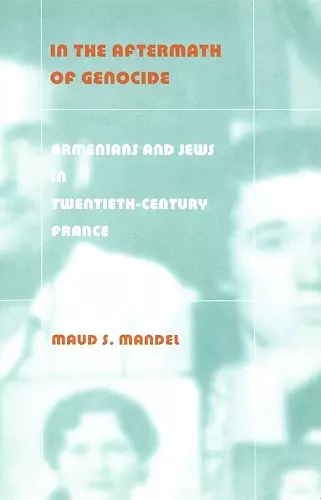In the Aftermath of Genocide
Armenians and Jews in Twentieth-Century France
Format:Hardback
Publisher:Duke University Press
Published:4th Jul '03
Currently unavailable, and unfortunately no date known when it will be back

A comparative study of two populations rebuilding their communities after being targets of genocide and the tensions that arise between national and transnational identities.
Offers a comparison of the country's Armenian and Jewish survivor communities. This book suggests that the consolidation of the nation-state system in Europe led survivors of genocide to fashion identities for themselves as ethnic minorities despite the dangers implicit in that status.France is the only Western European nation home to substantial numbers of survivors of the World War I and World War II genocides. In the Aftermath of Genocide offers a unique comparison of the country’s Armenian and Jewish survivor communities. By demonstrating how—in spite of significant differences between these two populations—striking similarities emerge in the ways each responded to genocide, Maud S. Mandel illuminates the impact of the nation-state on ethnic and religious minorities in twentieth-century Europe and provides a valuable theoretical framework for considering issues of transnational identity. Investigating each community’s response to its violent past, Mandel reflects on how shifts in ethnic, religious, and national affiliations were influenced by that group’s recent history. The book examines these issues in the context of France’s long commitment to a politics of integration and homogenization—a politics geared toward the establishment of equal rights and legal status for all citizens, but not toward the accommodation of cultural diversity.
In the Aftermath of Genocide reveals that Armenian and Jewish survivors rarely sought to shed the obvious symbols of their ethnic and religious identities. Mandel shows that following the 1915 genocide and the Holocaust, these communities, if anything, seemed increasingly willing to mobilize in their own self-defense and thereby call attention to their distinctiveness. Most Armenian and Jewish survivors were neither prepared to give up their minority status nor willing to migrate to their national homelands of Armenia and Israel.In the Aftermath of Genocide suggests that the consolidation of the nation-state system in twentieth-century Europe led survivors of genocide to fashion identities for themselves as ethnic minorities despite the dangers implicit in that status.
“France is a perfect setting for this exciting comparative study. Not only is it one of the places where both Armenians and Jews settled or re-settled after displacement, but it is a country which, due to its long history as a nation-state and its constantly reaffirmed ‘republican’ ideology, offers a particularly interesting case for an analysis of transnationalism-as-lived.”—Nancy L. Green, author of Ready-to-Wear and Ready-to-Work: A Century of Industry and Immigrants in Paris and New York
“This extraordinarily well-conceived book enriches scholarship on French Armenians and Jews by exploring how genocide shaped communal life and the processes by which national and ethnic identities converged in twentieth-century France.”—Leslie P. Moch, author of Moving Europeans: Migration in Western Europe since 1650
ISBN: 9780822331346
Dimensions: unknown
Weight: 635g
336 pages